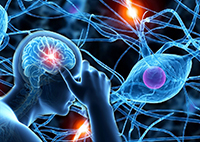COVID-19 is an emerging, rapidly evolving situation.
Get the latest public health information from CDC: https://www.coronavirus.gov
Get the latest research information from NIH: https://www.nih.gov/coronavirus
NIH staff guidance on coronavirus (NIH Only)
You are here
Piriformis Syndrome Information Page

Piriformis Syndrome Information Page
Piriformis Syndrome Information Page
What research is being done?
Within the NINDS research programs, piriformis syndrome is addressed primarily through studies associated with pain research. NINDS vigorously pursues a research program seeking new treatments for pain and nerve damage with the ultimate goal of reversing debilitating conditions such as piriformis syndrome.
Information from the National Library of Medicine’s MedlinePlus
Piriformis Syndrome
Metabolic Syndrome
Within the NINDS research programs, piriformis syndrome is addressed primarily through studies associated with pain research. NINDS vigorously pursues a research program seeking new treatments for pain and nerve damage with the ultimate goal of reversing debilitating conditions such as piriformis syndrome.
Information from the National Library of Medicine’s MedlinePlus
Piriformis Syndrome
Metabolic Syndrome
Within the NINDS research programs, piriformis syndrome is addressed primarily through studies associated with pain research. NINDS vigorously pursues a research program seeking new treatments for pain and nerve damage with the ultimate goal of reversing debilitating conditions such as piriformis syndrome.
Information from the National Library of Medicine’s MedlinePlus
Piriformis Syndrome
Metabolic Syndrome
Piriformis syndrome is a rare neuromuscular disorder that occurs when the piriformis muscle compresses or irritates the sciatic nerve-the largest nerve in the body. The piriformis muscle is a narrow muscle located in the buttocks. Compression of the sciatic nerve causes pain-frequently described as tingling or numbness-in the buttocks and along the nerve, often down to the leg. The pain may worsen as a result of sitting for a long period of time, climbing stairs, walking, or running.
Piriformis syndrome is a rare neuromuscular disorder that occurs when the piriformis muscle compresses or irritates the sciatic nerve-the largest nerve in the body. The piriformis muscle is a narrow muscle located in the buttocks. Compression of the sciatic nerve causes pain-frequently described as tingling or numbness-in the buttocks and along the nerve, often down to the leg. The pain may worsen as a result of sitting for a long period of time, climbing stairs, walking, or running.
Generally, treatment for the disorder begins with stretching exercises and massage. Anti-inflammatory drugs may be prescribed. Cessation of running, bicycling, or similar activities may be advised. A corticosteroid injection near where the piriformis muscle and the sciatic nerve meet may provide temporary relief. In some cases, surgery is recommended.
Generally, treatment for the disorder begins with stretching exercises and massage. Anti-inflammatory drugs may be prescribed. Cessation of running, bicycling, or similar activities may be advised. A corticosteroid injection near where the piriformis muscle and the sciatic nerve meet may provide temporary relief. In some cases, surgery is recommended.
Piriformis syndrome is a rare neuromuscular disorder that occurs when the piriformis muscle compresses or irritates the sciatic nerve-the largest nerve in the body. The piriformis muscle is a narrow muscle located in the buttocks. Compression of the sciatic nerve causes pain-frequently described as tingling or numbness-in the buttocks and along the nerve, often down to the leg. The pain may worsen as a result of sitting for a long period of time, climbing stairs, walking, or running.
Generally, treatment for the disorder begins with stretching exercises and massage. Anti-inflammatory drugs may be prescribed. Cessation of running, bicycling, or similar activities may be advised. A corticosteroid injection near where the piriformis muscle and the sciatic nerve meet may provide temporary relief. In some cases, surgery is recommended.
The prognosis for most individuals with piriformis syndrome is good. Once symptoms of the disorder are addressed, individuals can usually resume their normal activities. In some cases, exercise regimens may need to be modified in order to reduce the likelihood of recurrence or worsening.
The prognosis for most individuals with piriformis syndrome is good. Once symptoms of the disorder are addressed, individuals can usually resume their normal activities. In some cases, exercise regimens may need to be modified in order to reduce the likelihood of recurrence or worsening.
The prognosis for most individuals with piriformis syndrome is good. Once symptoms of the disorder are addressed, individuals can usually resume their normal activities. In some cases, exercise regimens may need to be modified in order to reduce the likelihood of recurrence or worsening.
Piriformis syndrome is a rare neuromuscular disorder that occurs when the piriformis muscle compresses or irritates the sciatic nerve-the largest nerve in the body. The piriformis muscle is a narrow muscle located in the buttocks. Compression of the sciatic nerve causes pain-frequently described as tingling or numbness-in the buttocks and along the nerve, often down to the leg. The pain may worsen as a result of sitting for a long period of time, climbing stairs, walking, or running.
Generally, treatment for the disorder begins with stretching exercises and massage. Anti-inflammatory drugs may be prescribed. Cessation of running, bicycling, or similar activities may be advised. A corticosteroid injection near where the piriformis muscle and the sciatic nerve meet may provide temporary relief. In some cases, surgery is recommended.
The prognosis for most individuals with piriformis syndrome is good. Once symptoms of the disorder are addressed, individuals can usually resume their normal activities. In some cases, exercise regimens may need to be modified in order to reduce the likelihood of recurrence or worsening.
Within the NINDS research programs, piriformis syndrome is addressed primarily through studies associated with pain research. NINDS vigorously pursues a research program seeking new treatments for pain and nerve damage with the ultimate goal of reversing debilitating conditions such as piriformis syndrome.
Information from the National Library of Medicine’s MedlinePlus
Piriformis Syndrome
Metabolic Syndrome










